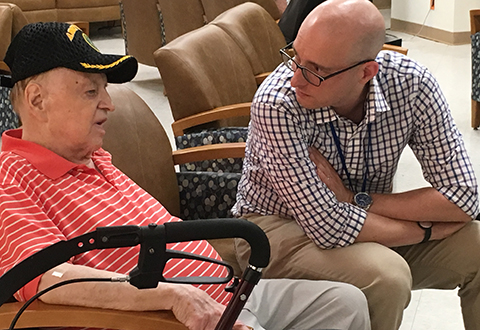New York/New Jersey VA Health Care Network
Definition of a Good Doctor: Courtesy and Respect

Dr. Jason Epstein talking with Veteran John Campbell.
Vietnam Army Veteran John Campbell has been coming to VA New York Harbor for services for at least 35 years. He’s an articulate man who wants his voice heard and action taken when he sees a need for improvement. His approach to problems is to be part of the solution.
Getting relief from lower back pain was the main reason for his recent visit to the hospital. An injection of an anesthetic he had received months ago had been effective, but the effect had worn off. Miscommunication about an appointment that had appeared to have been cancelled led him to be very angry. Mary Ellen Iglesias, a longtime secretary to the Executive Chief of Staff, who makes a point of addressing a Veteran’s concerns immediately above other priorities, quickly acted to address Campbell’s concerns.
Despite arriving within minutes, Dr. Epstein missed Campbell as he was anxious to make his access-a-ride back to New Jersey. He had left his contact information for the physician and Dr. Epstein and Veteran Campbell arranged over the phone to meet the following week.
At that recent meeting, Dr. Epstein and Campbell talked at length about the Veteran’s medical issues. It was clear that being treated with respect was at least as important to Campbell as getting relief from pain. This was not surprising at all to Dr. Epstein.
“One of the last lectures we received in medical school was by a professor who was close to retirement,” Dr. Epstein recalled.
“He told us that he knew the secret to being a good doctor. He was going to tell us, but he promised we wouldn’t believe him until we were much older and wiser. He said to us that it didn’t really matter if you saved someone’s life, prescribed the correct medication, treated their pain or cured their disease. If you wanted to be a good doctor, he said, then call your patients back. That’s it. That simple human courtesy goes a very long way.”
Regarding Mr. Campbell’s upcoming treatment for pain, Dr. Epstein said that if a treatment has been successful for a patient in the past, it is reasonable to try it again. Shots of steroids or lidocaine may be very effective. Pleased with how his interaction was going with Dr. Epstein, Veteran Campbell was very appreciative that the physician agreed to make every effort to have the procedure scheduled within several weeks.
“If you can make it the first week of August I’d be very appreciative,” he said several times.
Dr. Epstein, a board-certified anesthesiologist and interventional pain physician, was on staff at the James J Peters VA Medical Center in the Bronx before coming to the Harbor less than a month ago. He hopes to set up telehealth access for pain management patients to allow them to consult with a clinician remotely. These consultations may work toward clarifying for both patient and clinician the mechanics of what is causing chronic pain.
“Pain can be misleading,” said Dr. Epstein. “Sciatica coming from the back, may cause a sharp pain that is felt in the toe or foot. Inflammation of a nerve may cause pain far away from the location of the injury or dysfunction.”
Pain Management doctors work closely with primary care providers, neurologists, psychiatrists, orthopedists and neurosurgeons who refer the patients to them for expert evaluation and pain interventions. Frequently patients with sciatica or arthritis limit their movement to minimize discomfort. Medication given by injection to reduce inflammation or block a nerve often provides enough relief for a patient to engage in activities of life and exercise that further strengthen the core muscles. In some cases, more invasive procedures are considered the best option for long term relief.
“We rarely can get to zero pain, but our goal is to make a functional improvement,” Dr. Epstein said.
He said that while taking patients’ physical history in person is essential, speaking with them as soon as possible is a powerful way to address their concerns and provide reassurance that something can be done. This, of course, is followed by a complete assessment aimed at diagnosing and the treating the cause of the pain.
















